Every Monday morning, artnet News brings you The Gray Market. The column decodes important stories from the previous week—and offers unparalleled insight into the inner workings of the art industry in the process.
This week, two stories about auction value that go deeper than estimates…
THE MARSHALL PLAN
On Wednesday, Ruth Lopez of The Art Newspaper reported on the city of Chicago’s controversial plan to sell Kerry James Marshall’s Knowledge and Wonder, a mural painted in 1995 for a local public library on the city’s predominantly African American, economically challenged west side.
Commissioned for an artist’s fee of $10,000, the piece will mount the auction block at Christie’s New York next month with an estimate of $10 million to $15 million. Proceeds from the sale will go toward significantly upgrading the same library that housed the painting by extending its operating hours and expanding its resources, as well as establishing a public-art fund for overlooked communities.
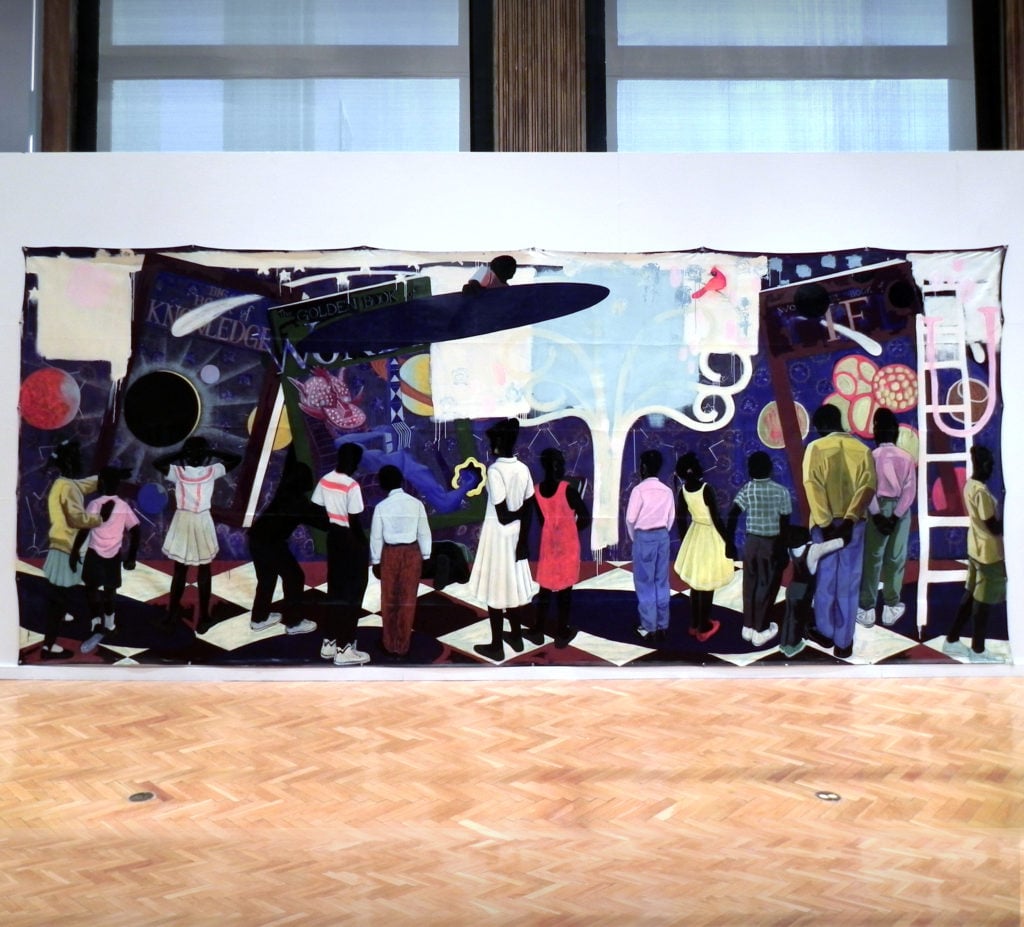
Kerry James Marshall Knowledge and Wonder (1995). Photo: courtesy of Christie’s.
Although some outlets initially characterized Marshall as supportive of the plan, he remarked at the Wednesday night opening of his new show at David Zwirner in London that Chicago “has wrung every bit of value they could from the fruits of my labor.” He noted that just last year he accepted a symbolic fee of one dollar to realize another mural roughly 10 times the size of Knowledge and Wonder on the Chicago Cultural Center’s exterior.
Also relevant (though left unsaid by Marshall) is this May’s record-setting, $21.1 million sale of the artist’s Past Times, a work acquired for $25,000 in 1997 by Chicago’s Metropolitan Pier and Exposition Authority. Proceeds of that sale will be directed toward a long-term $500 million maintenance effort for the McCormick Place convention center, where Past Times hung for nearly 20 years.
Now, there are more issues to address in this story than in People magazine’s mailroom. Since plenty of smart folks have already addressed many of them, though, I want to focus on the intellectual trap that the impending sale has invited many of us to waltz into.
ARTnews relayed Marshall’s remarks that Chicago “could get more money if they sold the Picasso sculpture in Daley Plaza,” a reference to the untitled 50-foot corten steel composition that is arguably the city’s most important public artwork. Although it was clearly sarcastic, the quip blasted open the vaults concealing uncomfortable questions about which pieces of a city’s public art collection are expendable, what circumstances should make them expendable, and who gets to decide.
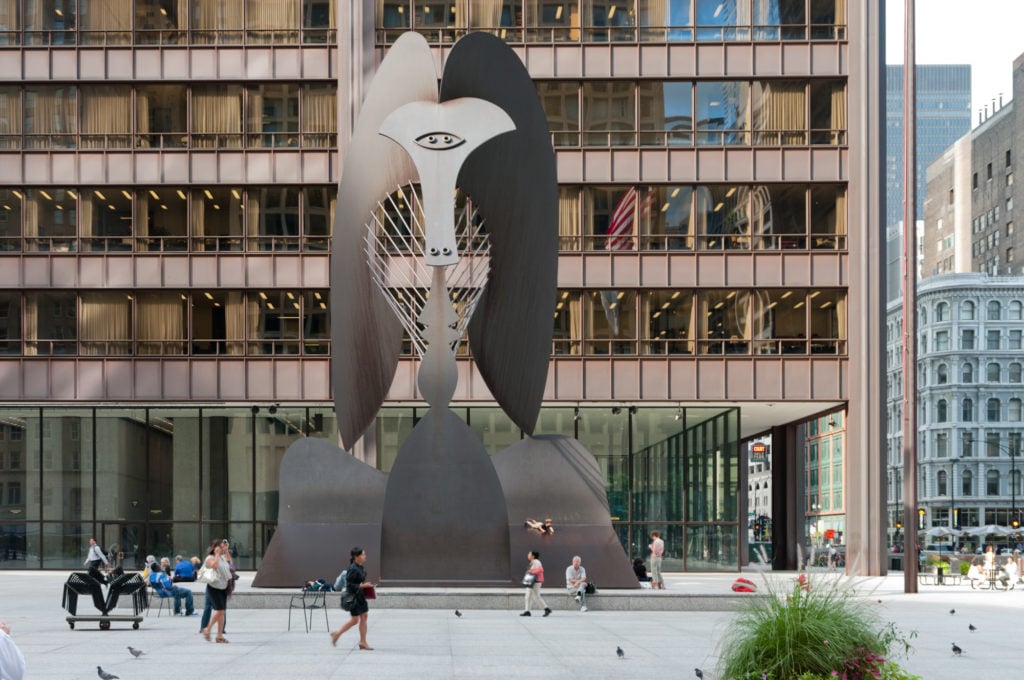
Pablo Picasso, Untitled (commonly known to Chicagoans as ‘The Picasso’), 1967. Image courtesy of Flickr user Dan DeLuca.
Similarly, in Lopez’s TAN piece, artist and former Chicago cultural affairs department staffer Barbara Koenen suggests that the city could instead flip Richard Serra’s Reading Cones (1988) to generate equivalent revenue. Unlike Marshall, she says, Serra has “no connection to Chicago, and the city has never known where to put” the work anyway. (It currently occupies part of Grant Park.) And while I would agree with Koenen in a finale-of-the-Bachelor-style face-off between the two pieces, entertaining that choice also channels us into a false framework for thinking through the larger issue.
I consider myself to be a deaccessioning pragmatist (which, in many people’s eyes, actually makes a me a deaccessioning philistine). But one key reason that I think museums should be given more leeway in this department stems from their limited options in times of financial crisis. If an arts institution nears bankruptcy, what other assets could it sell to preserve its role in the community besides some of the works in its collection?
This is not the case for major American cities. Even if we act as if Chicago’s only option to fund the library’s expansion is to sell assets—which of course, it isn’t—then we should recognize that there is no particular requirement for those assets to be artworks.
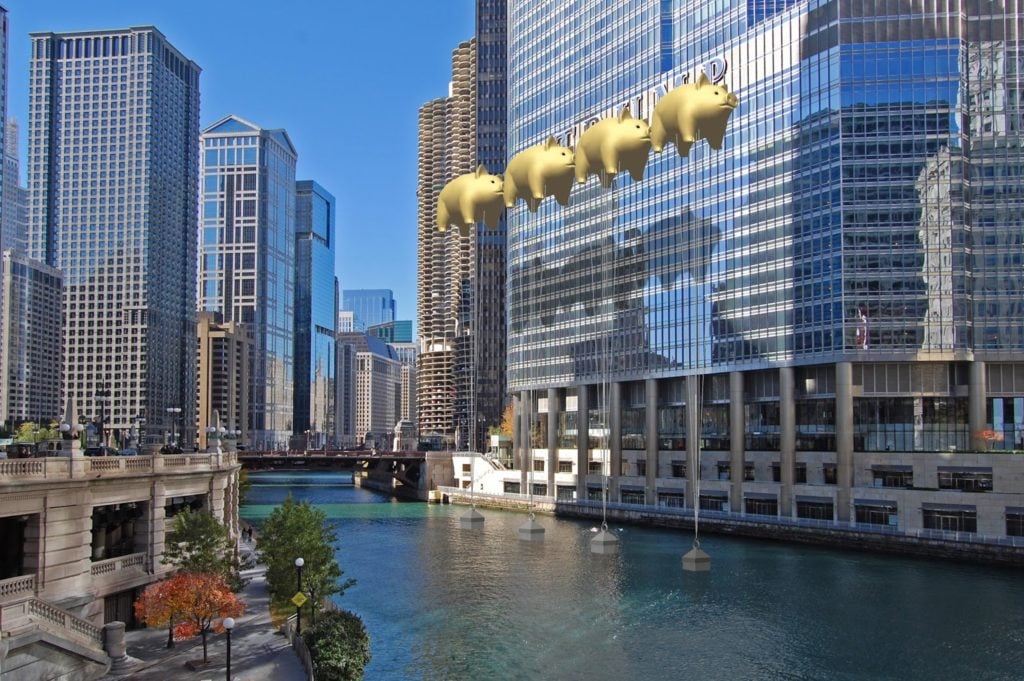
New World Design, Flying Pigs on Parade: a Chicago River Folly (2016). Courtesy New World Design.
For instance, Chicago owns plenty of real estate. Could officials auction land or buildings to generate the $10 million–15 million they want to upgrade the library where Knowledge and Wonder hangs? No doubt. As of my writing, the city-owned land inventory shows Chicago’s real-estate portfolio consisting of nearly 11,000 parcels of available property.
Granted, some of those lots have been deemed effectively worthless. (The city offered nearly 1,000 lots for one dollar each through its Large Lots Program in 2017.) But public records reflect that, in a single ward near DePaul University, Chicago generated about $9.5 million in property sales between January 1, 2013 and August 31, 2015—nearly Christie’s low estimate for Marshall’s mural.
I get why the city sees a solution in selling the work. How else can a bureaucracy generate so much cash so quickly from such a modestly sized asset? But it also perpetuates a disturbing mentality that I’ve found myself writing about again and again this year: namely, that culture—particularly in underserved neighborhoods—is only a priority if and when the costs can be covered by private-sector patrons. In that sense, auctioning off Knowledge and Wonder may be a temporary fix. But I fear we’re also at risk of it becoming a lasting metaphor.
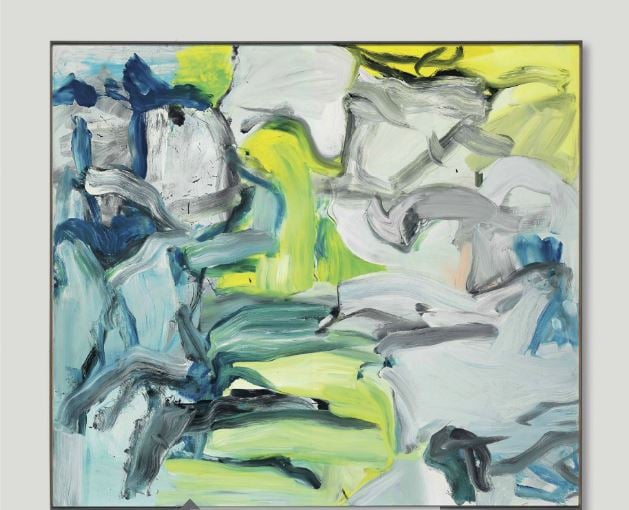
Willem de Kooning, Untitled III (1978). Courtesy Christie’s Images Ltd.
MAKING A KILLEN
Finally this week: On Thursday, Vulture checked in with David Killen, the Chelsea dealer/auctioneer who, in late summer, may or may not have acquired six Willem de Kooning works buried in the scattershot contents of a New Jersey storage locker for a cool $15,000. Killen will auction the possible de Koonings over the course of three separate sales at his gallery between mid-October and mid-December. He says he has little sense of how much they might fetch given their shaky provenance. And while I think he’d be right to keep his expectations modest, I wouldn’t say the same for whoever buys them.
The two checkmarks in Killen’s favor are faint. First, he claims to have received a favorable attribution ruling from a university professor who wishes to remain anonymous. Second, and much more interesting, he has the memories of Lawrence Castagna, a former assistant to both de Kooning and Orrin Riley, a freelance restorer and founder of the Guggenheim’s conservation department. According to Vulture, Castagna viewed the six pieces with Killen and “thought that the paintings might have been in Riley’s restoration studio” while he worked there.
However, Sotheby’s already turned down Killen’s offer to consign the works—a fact that suggests its experts may have considered the pieces either too risky or insufficiently promising to put in-house authentication resources behind. The de Kooning estate does not authenticate works, either. All of which explains why Killen is left to say only, “My hope is that serious people come to the exhibition, bring their expert with them, and let the expert whisper in their ear, ‘Yeah, they’re real.’”
To be clear, I think there’s a strong probability that this happens. The fact is that once-questioned works have a tendency to end up with the sexiest possible attributions only after they’re acquired by sufficiently wealthy or powerful new owners. Dissecting why tells us a lot about the workings of the art market.
When it comes to assigning authorship to potential lost masterpieces like Killen’s storage find, there’s an eternal chicken-versus-egg problem. On the one hand, this phenomenon might happen because connoisseurial buyers and their agents are more sensitive to the hand of genius than less connoisseurial ones. On the other, it might also happen because history has demonstrated again and again that, if you dedicate enough money and effort to anything legitimately in question, you can often succeed in bending perception to your will.
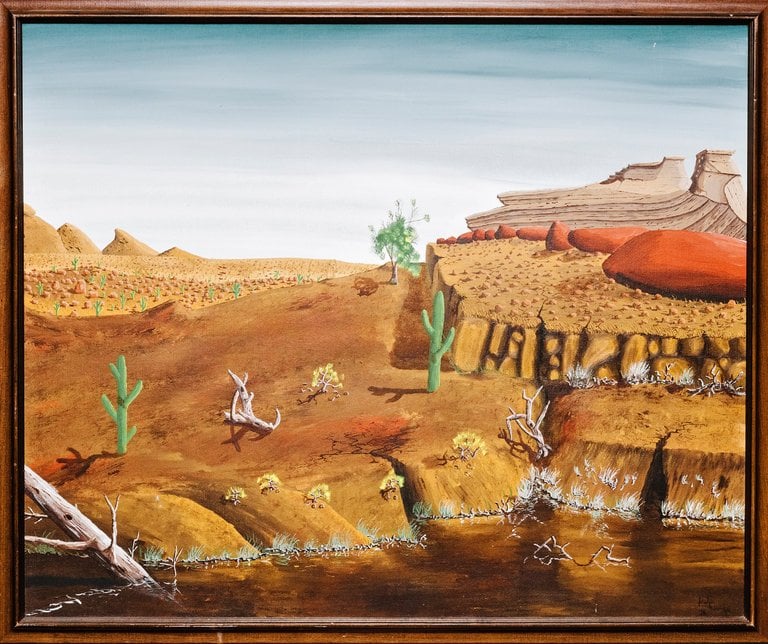
Peter Doig spent five years defending against a lawsuit claiming that he had painted the above landscape work, signed “Peter Doige,” as a teenager. Courtesy ARIS Title @ARIS_ArgoGroup via Twitter.
Remember, in situations like Killen’s are-they-or-aren’t-they de Koonings, the task of proving authorship without a shadow of a doubt lands somewhere just south of impossible. Time is a bandit, stealing more useful information with every passing year (let alone decade or century). Most artists’ estates have by now parachuted out of the authentication business entirely because of its potential to fly them into legal jeopardy like an alcoholic airline pilot. Even the word of the living artist is losing its power to end disputes. Remember, it took Peter Doig five years and a trial to kill a small-time dealer’s claim that he had possession of a work Doig painted as a teenage inmate at a correctional facility the artist never actually served time in.
Meanwhile, what has been the common thread in the most high-profile reattribution cases of the past few years? A years-long process to study (and study, and study) questionable pieces until they were deemed legitimate. Just read this handy timeline of Salvator Mundi’s path to Leonardo-hood, or consider the international team of experts who concluded in 2015 that a pair of long-extant bronze figures were in fact the only surviving Michelangelo works in that medium. The takeaway from both cases is the same: These meticulous, long-term, cross-disciplinary investigations require cash money. The higher your stack, the greater your ability to will them into being.
There’s another vital factor in play here, too. While I am not suggesting people are being bribed or unduly influenced to rule a certain way in re-attribution cases, I also think it’s crucial to acknowledge that there are far more incentives compelling different parties to label rediscovered pieces as so-called “autograph works” by masters rather than also-ran works by anyone else. And in the words of finance wizard Charlie Munger, Warren Buffett’s partner in Berkshire Hathaway, “Show me the incentives, and I’ll show you the outcome.”
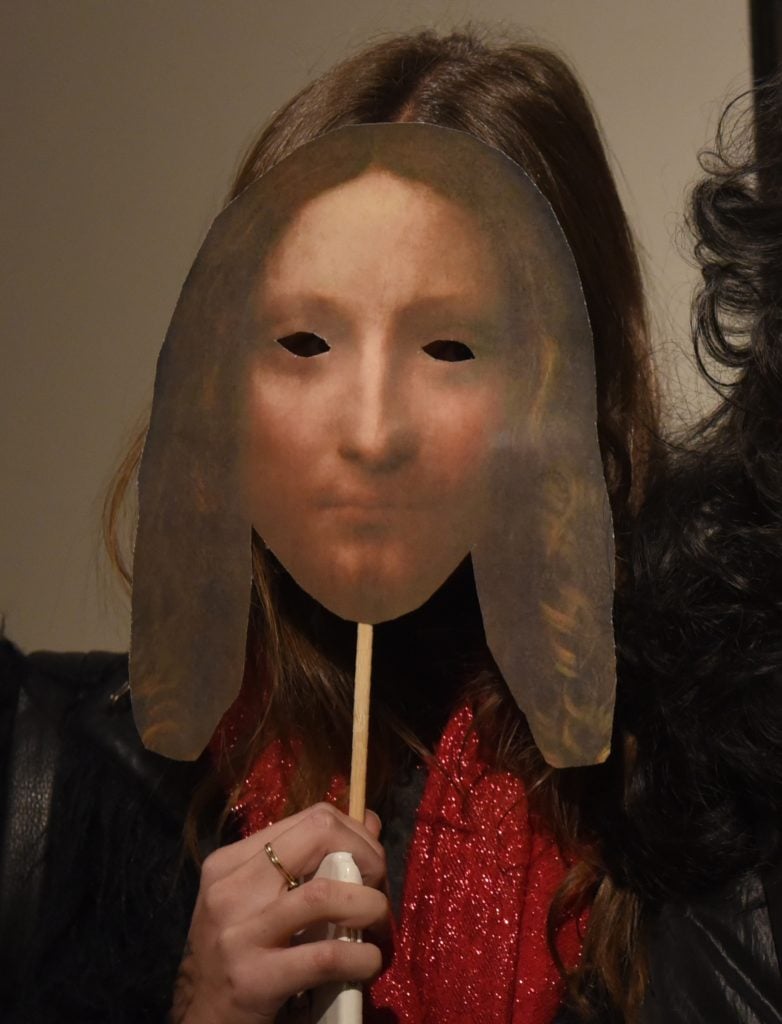
A woman holds up a paddle with the likeness of Leonardo da Vinci’s “Salvator Mundi” at Christie’s. (TIMOTHY A. CLARY/AFP/Getty Images)
Think about what happens when a work with a murky past or a boring attribution suddenly levels up to being the work of a late genius: The commercial side gets an opportunity to make more money. The academic side gets new material to research (and possibly new funding for the effort). The press gets to tell a great story. Average people get to read that story and rekindle a faint hope that, against all odds, a life-changing discovery like this one might fall into their own laps someday.
In fact—and this is crucial—as long as you can rule out forgery and rule in relatively sufficient quality (i.e. no Beast Jesus situations), there are almost no downsides to attributing a found work to a great artist. The worst that happens is that the decision angers a subset of niche experts who feel the work is illegitimate. And even those people benefit in the end, because the debate builds them a platform to write papers, attend conferences, and give lectures where they get to play the incredulous skeptic. Everybody wins!
Based on all this, I’d expect at least one of Killen’s storage-locker de Koonings to follow a version of the trajectory we saw with Salvator Mundi between 2005 and 2013: get acquired for a modest number by a group of anonymous investors (who are pricing in risk and future costs), disappear for a few years to undergo extensive further testing, re-emerge with a bevy of new evidence reinforcing the de Kooning attribution, and sell to a high-profile client at many multiples of the price achieved at Killen’s gallery this year.
In the end, it’s what the people want. And sometimes, the art market really can deliver that to everyone.
That’s all for this week. ‘Til next time, remember: There’s more to almost everything than meets the eye.













